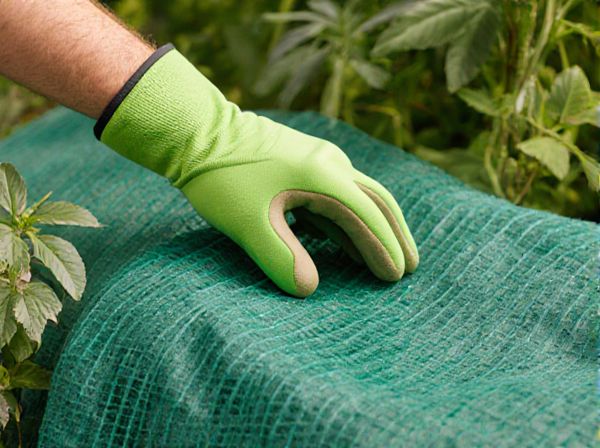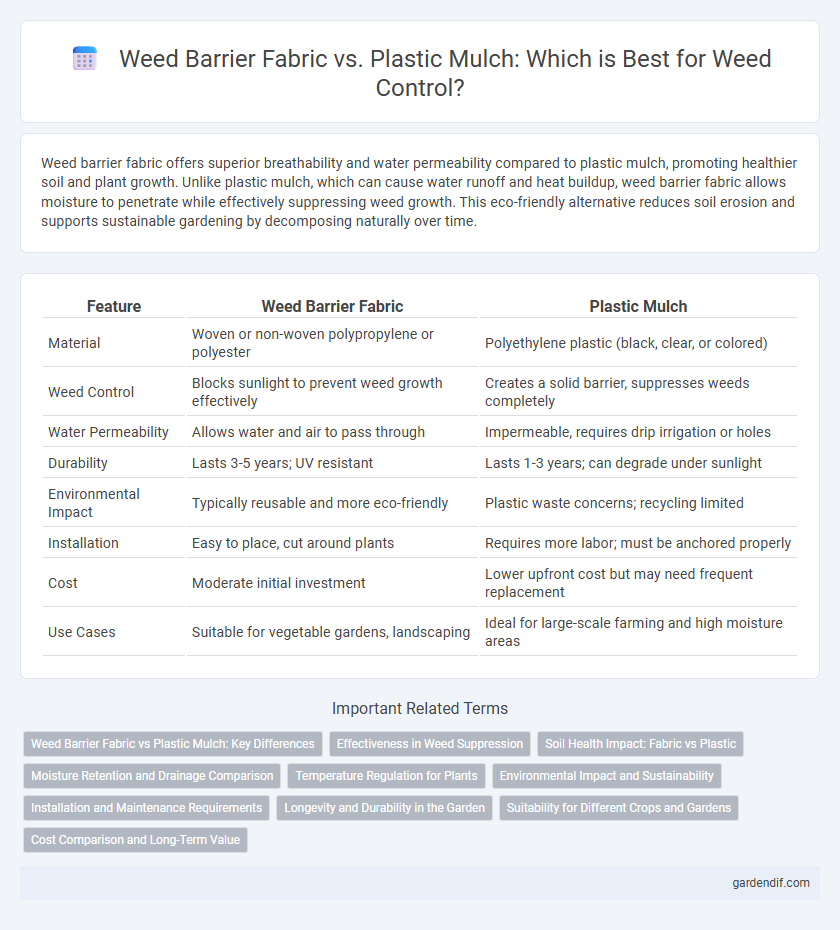
Weed barrier fabric vs plastic mulch Illustration
Weed barrier fabric offers superior breathability and water permeability compared to plastic mulch, promoting healthier soil and plant growth. Unlike plastic mulch, which can cause water runoff and heat buildup, weed barrier fabric allows moisture to penetrate while effectively suppressing weed growth. This eco-friendly alternative reduces soil erosion and supports sustainable gardening by decomposing naturally over time.
Table of Comparison
| Feature | Weed Barrier Fabric | Plastic Mulch |
|---|---|---|
| Material | Woven or non-woven polypropylene or polyester | Polyethylene plastic (black, clear, or colored) |
| Weed Control | Blocks sunlight to prevent weed growth effectively | Creates a solid barrier, suppresses weeds completely |
| Water Permeability | Allows water and air to pass through | Impermeable, requires drip irrigation or holes |
| Durability | Lasts 3-5 years; UV resistant | Lasts 1-3 years; can degrade under sunlight |
| Environmental Impact | Typically reusable and more eco-friendly | Plastic waste concerns; recycling limited |
| Installation | Easy to place, cut around plants | Requires more labor; must be anchored properly |
| Cost | Moderate initial investment | Lower upfront cost but may need frequent replacement |
| Use Cases | Suitable for vegetable gardens, landscaping | Ideal for large-scale farming and high moisture areas |
Weed Barrier Fabric vs Plastic Mulch: Key Differences
Weed barrier fabric offers breathability and water permeability, allowing soil moisture to pass through while effectively suppressing weed growth, whereas plastic mulch acts as a solid barrier that conserves soil moisture but may cause overheating and reduced air exchange. Unlike plastic mulch, which breaks down quickly under UV exposure, weed barrier fabric is more durable and reusable for multiple growing seasons. The choice between weed barrier fabric and plastic mulch depends on crop type, climate conditions, and long-term soil health management.
Effectiveness in Weed Suppression
Weed barrier fabric offers superior effectiveness in weed suppression by allowing water and air permeability, which promotes healthy soil while preventing weed growth through physical blockage. Plastic mulch, though effective in blocking sunlight and thus inhibiting weeds, can trap moisture excessively, potentially leading to soil overheating and reduced soil aeration. Studies show weed barrier fabric reduces weed emergence by up to 90% compared to plastic mulch's approximately 75%, making it a more efficient choice for long-term weed control.
Soil Health Impact: Fabric vs Plastic
Weed barrier fabric promotes better soil health by allowing air and water to penetrate, maintaining moisture balance and supporting microbial activity, while plastic mulch creates a barrier that restricts airflow and water infiltration, potentially leading to soil compaction and reduced microbial diversity. Fabric's permeability encourages beneficial earthworm activity and nutrient cycling, which enhances soil structure over time. In contrast, plastic mulch can increase soil temperature excessively and hinder natural soil processes, impacting long-term fertility and plant growth.
Moisture Retention and Drainage Comparison
Weed barrier fabric provides superior moisture retention by allowing water and air to permeate the soil, promoting healthy root growth and preventing waterlogging. Plastic mulch, while effective at suppressing weeds, tends to trap moisture beneath its impermeable surface, which can lead to poor drainage and root rot. Choosing weed barrier fabric enhances soil aeration and drainage balance, making it ideal for crops requiring consistent moisture without excessive saturation.
Temperature Regulation for Plants
Weed barrier fabric allows better air and water permeability, promoting more stable soil temperatures and reducing heat stress on plant roots compared to plastic mulch. Plastic mulch typically absorbs and retains more heat, which can increase soil temperature but may risk overheating in warmer climates. Choosing weed barrier fabric helps maintain a balanced root environment, optimizing plant growth by preventing extreme temperature fluctuations.
Environmental Impact and Sustainability
Weed barrier fabric offers superior environmental benefits compared to plastic mulch by being more durable, reusable, and often made from biodegradable materials, reducing landfill waste and microplastic pollution. Unlike plastic mulch, which contributes significantly to soil and water contamination due to its non-biodegradable nature, weed barrier fabric promotes healthier soil ecosystems by allowing better air and water permeability. Sustainable gardening practices favor weed barrier fabric as it minimizes plastic dependency and supports long-term soil health, enhancing ecological balance.
Installation and Maintenance Requirements
Weed barrier fabric involves straightforward installation by unrolling and securing it with landscape staples, allowing water and air permeability that reduces soil compaction and promotes healthy plant growth. Plastic mulch requires precise laying and anchoring to avoid tearing, and careful irrigation management since it obstructs water infiltration, demanding drip irrigation or frequent manual watering. Maintenance for weed barrier fabric is minimal as it can be reused multiple seasons, whereas plastic mulch often needs replacement each season due to degradation and tearing.
Longevity and Durability in the Garden
Weed barrier fabric offers superior longevity and durability compared to plastic mulch, resisting tears and UV degradation for multiple growing seasons. Its permeable nature allows water and nutrients to penetrate the soil while maintaining structural integrity. In contrast, plastic mulch tends to degrade quickly under sunlight, becoming brittle and requiring frequent replacement.
Suitability for Different Crops and Gardens
Weed barrier fabric offers superior breathability and water permeability, making it ideal for vegetable gardens and fruit beds where root aeration is crucial. Plastic mulch excels in heat retention and moisture conservation, benefiting warm-season crops like tomatoes and peppers requiring consistent soil temperature. Both options serve distinct plant needs, with fabric favored for diverse, mixed crops and plastic mulch preferred in monoculture or high-heat environments.
Cost Comparison and Long-Term Value
Weed barrier fabric generally costs more upfront than plastic mulch but offers superior durability, reducing replacement frequency and lowering long-term maintenance expenses. Plastic mulch tends to be cheaper initially but may degrade faster, leading to additional costs for disposal and reapplication. Considering long-term value, weed barrier fabric provides better weed suppression and soil health benefits, resulting in greater cost efficiency over multiple growing seasons.
Weed barrier fabric vs plastic mulch Infographic

 gardendif.com
gardendif.com